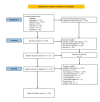Thromboelastography in the Perioperative Period: A Literature Review
- PMID: 37362492
- PMCID: PMC10287184
- DOI: 10.7759/cureus.39407
Thromboelastography in the Perioperative Period: A Literature Review
Abstract
Assessing coagulation status is essential for prompt intervention to reduce morbidity and mortality related to bleeding and thrombotic complications during the perioperative period. Traditional coagulation tests such as platelet count, activated partial thromboplastin time (aPTT), prothrombin time (PT), international normalized ratio (INR), and activated clotting time (ACT) provide only static evaluation. These tests are not designed for assessment of dynamically changing coagulation conditions during the perioperative time. However, viscoelastic coagulation testing such as thromboelastography (TEG) produces a rapid numerical and graphical representation that helps to detect and direct targeted hemostatic therapy. Searching the literature through PubMed, Medline, Ovid, CINAHL, and ClinicalTrials.gov we retrieved 210 studies, which represent the use of TEG in the perioperative period. The included studies were categorized under various settings such as trauma, obstetrics, orthopedics, intensive care unit (ICU), cardiovascular, transplant, and miscellaneous scenarios. TEG showed promising results in trauma surgeries in predicting mortality, hypercoagulability, and bleeding even when it was compared to conventional methods. TEG was also useful in monitoring anticoagulant therapy in orthopedic and obstetric surgeries; however, its role in predicting thrombotic events, hypercoagulability, or complications was questionable. In ICU patients, it showed promising results, especially in the prediction or improvement of sepsis, coagulopathy, thrombotic events, ICU duration, hospital stay, and ventilator duration. TEG parameters effectively predicted hypercoagulation in transplant surgeries. Regarding cardiovascular surgeries, they were effective in the prediction of the need for blood products, coagulopathy, thrombotic events, and monitoring anticoagulation therapy. More randomized clinical trials comparing TEG parameters with standardized tools are needed to produce robust results to standardize its use in different perioperative settings.
Keywords: coagulation; outcomes; perioperative period; teg; thromboelastography; transfusion.
Copyright © 2023, Ramanujam et al.
Conflict of interest statement
The authors have declared that no competing interests exist.
Figures
References
-
- Thromboelastography: Clinical application, interpretation, and transfusion management. Collins S, MacIntyre C, Hewer I. https://www.aana.com/docs/default-source/aana-journal-web-documents-1/jc... AANA J. 2016;84:129–134. - PubMed
-
- Thromboelastography identifies children with rare bleeding disorders and predicts bleeding phenotype. Zia AN, Chitlur M, Rajpurkar M, Ozgonenel B, Lusher J, Callaghan JH, Callaghan MU. https://doi.org/10.1111/hae.12481. Haemophilia. 2015;21:124–132. - PubMed
-
- Thromboelastography (TEG) or thromboelastometry (ROTEM) to monitor haemostatic treatment versus usual care in adults or children with bleeding. Wikkelsø A, Wetterslev J, Møller AM, Afshari A. https://doi.org/10.1002/14651858.CD007871.pub3. Cochrane Database Syst Rev. 2016;2016:0. - PMC - PubMed
-
- Thromboelastography (TEG) or rotational thromboelastometry (ROTEM) to monitor haemostatic treatment in bleeding patients: a systematic review with meta-analysis and trial sequential analysis. Wikkelsø A, Wetterslev J, Møller AM, Afshari A. Anaesthesia. 2017;72:519–531. - PubMed
Publication types
LinkOut - more resources
Full Text Sources

